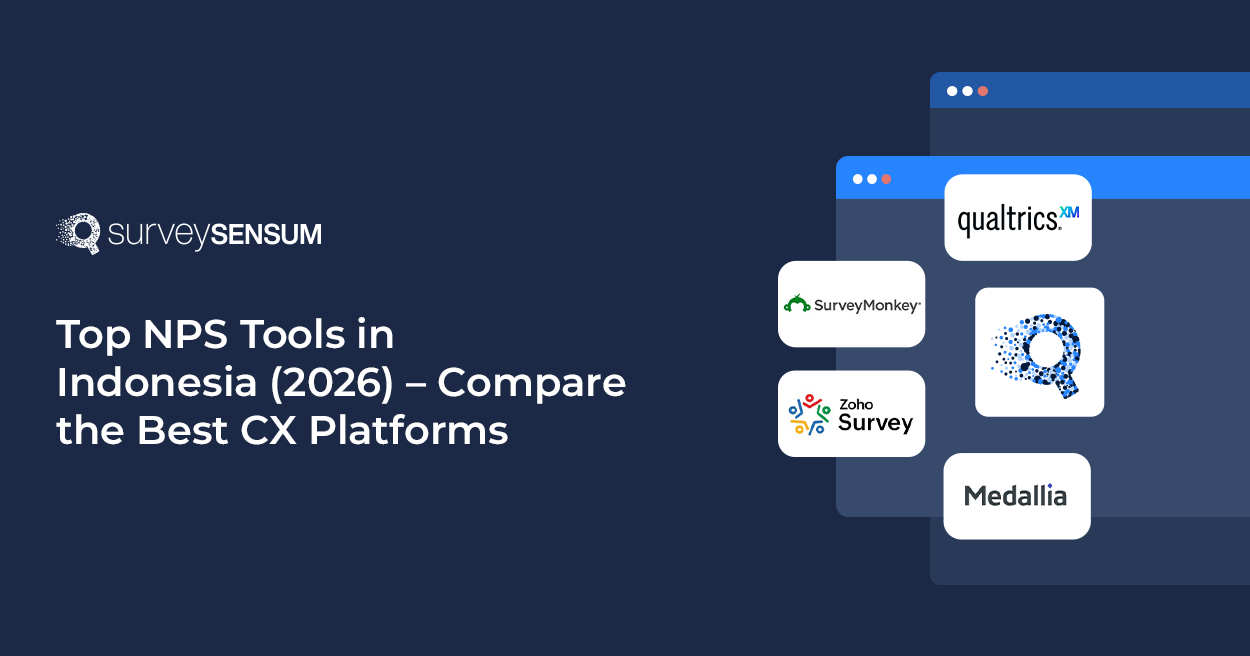

Did you know that 39% of users will abandon a website due to a poor user experience? Or that 88% won’t even return to a website after a negative experience?
But do you know why does this digital exodus happen?
Because, in a world where every second counts, a slow, confusing, or unfriendly website is like a one-way ticket to user abandonment.
So, how do you ensure your website ticks all the right boxes for your audience? — By gathering website feedback and enhancing its usability.
Think of website usability as the seamless journey users should have while navigating your site—finding what they seek without breaking a sweat. Crafting this ideal user experience involves clear navigation, meaningful content, responsive design, easy accessibility across devices and browsers, and utilizing an effective website feedback tool for continuous improvement.
You must know what your visitors think to ensure your website serves its purpose. Are they finding what they want? Is your content meaningful to them? Are they on the path to becoming a “customer”?
Now that we’ve explored the importance of a smooth user journey let’s delve into how website usability surveys play a crucial role in understanding and enhancing this experience.
What are Website Usability Surveys?
A website usability survey asks questions about page load speed, design, and content that can unveil some needed insights. From score-based questions to star ratings and open-ended questions, it’s your way to decoding your audience’s digital journey.
Ready to know what makes your visitors click? Let’s explore the world of website usability surveys starting with why should you launch these surveys!
Why Should You Launch Website Usability Surveys?
The importance of website usability surveys lies in several compelling reasons, such as:
- Identifying Customers’ Concerns: Launching these surveys allows pinpointing specific issues users face while navigating your website. For instance, information accessibility, confusing navigation, or technical glitches. Tackling these concerns enhances the overall customer experience.
- Reducing Bounce Rates: Through website experience surveys, you can uncover the causes behind high bounce rates—like irrelevant content, slow loading times, or low engagement—becomes feasible. Addressing these issues helps in retaining visitors and boosting user engagement.
- Identifying Conversion Barriers: By assessing the ease of completing actions such as making purchases or signing up, these surveys assist in identifying and optimizing conversion barriers, enhancing conversion rates along the user journey.
- Understanding User Sentiment: By gathering visitor feedback about their website experience, you can gain insights into whether users find it enjoyable, frustrating, or neutral. This understanding facilitates targeted improvements, elevating customer satisfaction, and fostering loyalty.
- Collecting Unbiased Feedback: Website usability surveys provide a platform to gather unbiased, unfiltered feedback directly from users. This raw feedback reflects authentic user experiences and opinions, enabling informed decision-making regarding website enhancements.
Now, the common question you might have in your mind is – what is the ideal time to ask a feedback on website experience?
When Is The Ideal Time To Launch a Website Usability Survey?
Here are specific scenarios where gathering user feedback on a website becomes invaluable to understanding visitor’s behavior.
| Type of Website Feedback | When to Collect | Where to Collect | How to Collect |
| Feature Enhancement | When new features or functionalities are introduced | On feature pages or via pop-up surveys | Use targeted in-app surveys or email notifications |
| Addressing High Bounce Rates or Low Conversions | When observing rapid user exits or decline in conversions | On exit pages or at the end of user sessions | Implement exit surveys or session-based feedback forms |
| Pre-Marketing Campaign Preparation | Before launching a marketing campaign | Homepage or landing pages | Employ online forms or email surveys targeting potential campaign users |
| Validating Content Modifications | After making significant content changes | On specific content pages or after user interaction | Use contextual surveys or feedback widgets within content areas |
| Post-Purchase Evaluation | After customers make a purchase | Confirmation page or follow-up emails | Utilize post-purchase survey emails or feedback forms on confirmation pages |
- Feature Enhancement: Each time you introduce new features or functionalities to your website, you must solicit user feedback. This allows for assessing how these changes are received and ensure users can effectively utilize the new functionalities.
- Addressing High Bounce Rates or Low Conversions: These surveys aid in understanding why users are leaving and implementing improvements to retain those visitors.
- Pre-Marketing Campaign Preparation: Guaranteeing a seamless user experience before launching a marketing campaign is pivotal for achieving campaign goals and maximizing conversions as it allows you to optimize the website for campaign success in advance.
- Validating Content Modifications: Confirming content changes through website feedback ensures that presented information is clear, relevant, and effectively communicates the intended message. This validation enhances the overall user experience by aligning content with user expectations.
- Post-Purchase Evaluation: Following customer purchases from your website, posing website usability survey questions becomes instrumental in assessing the overall shopping experience. This evaluation aims to enhance the buying process, elevate customer satisfaction, and foster repeat business.
Launch Website Usability Surveys with SurveySensum
8 Types of Questions to Ask in the Website Usability Survey
The typical bounce rate falls between 41% and 55%, often attributed to unengaging content, navigation challenges, or other elements contributing to an unsatisfactory user experience.
That makes it even more important to know about the users’ experience expectations.
With the help of the following questions, you can create a seamless user experience on your website:
1. General Usability or Website Experience Survey Questions
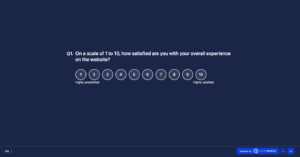
The general website usability survey is designed to grasp the overall user-friendliness of your website, gathering insights on what visitors appreciate or find challenging. It allows users to share their dislikes, challenges, and suggestions, aiming to enhance the website’s accessibility and usability.
Net promoter score questions also help gauge the likelihood of users recommending your website to others.
Consider asking these website user experience survey questions:
- What did you like the most, or what stood out on our website?
- Would you like to change anything on our website?
- On a scale of 1 to 10, how satisfied are you with your overall experience on the website?
- Did you face any challenges while using our website?
- Please share any comments or suggestions you may have.
2. Design Usability Survey Questions
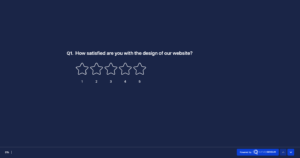
75% of people form opinions about a company’s credibility by checking out their website design. Yep, it’s true! That’s because most of our initial impressions come from a website’s appearance.
The website’s design comprises visual elements like colors, font type and size, button size and color, image style, and more. It also encompasses design features such as the placement of the menu bar and whether it remains at the top of the screen during user scrolling. Then how do these surveys help?
Ask the following questions if you wanna know what kind of impression your website has on the users:
- How satisfied are you with the design of our website?
- How would you rate the color palette chosen for our website?
- Did you differentiate between links and the other content?
- How useful and relevant were the images?
3. Mobile-Responsiveness Usability Survey Questions
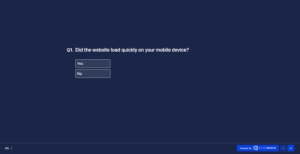
74% of users are more likely to revisit your website if it is mobile-responsive. That’s a staggering number!
But how do you know if your website gives that optimal mobile customer experience? That’s where mobile-responsiveness usability survey questions come in, helping you understand if users can easily access it on their smartphones.
Use the following as mobile-responsiveness website usability survey examples:
- Did the website load quickly on your mobile device?
- Did you encounter any difficulties navigating the website on your mobile device?
- How would you rate the usability of our website on your smartphone?
- How would you rate the design of our website on your smartphone?
4. Website Redesigning Survey Questions
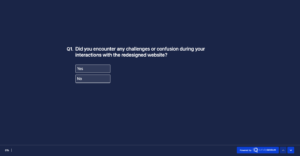
Website redesign surveys play a vital role for businesses and organizations aiming to refresh their online image. They’re designed to collect input from current and potential customers, ensuring the new design meets their requirements. This gathered feedback guides the redesign process, ensuring the end product is user-friendly, visually appealing, and meets the intended objectives effectively.
Ask the following questions in the survey:
- What did you like the most about our existing website?
- Did you encounter any challenges or confusion during your interactions with the redesigned website?
- Could you please let us know the aspects you dislike on our existing website?
- Is there anything you would like to see on our new website that needs to be added to our existing website?
5. Navigation Usability Survey Questions
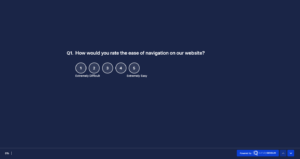
Navigation is a crucial element that determines a website’s performance. It involves how users explore a website, moving between pages and scrolling through content. The survey assists in restructuring the website’s navigation so that the visitors can find what they seek. In this way, it will help you enhance your strategies for converting them into customers.
Use these website usability survey questions to determine if users can easily navigate to what they are looking for:
- How would you rate the ease of navigation on our website?
- Are you able to use all the links on our website?
- Do you feel that all the links on our website take you to the right page?
- Were you able to navigate to your desired page easily?
6. Content Usability Survey Questions
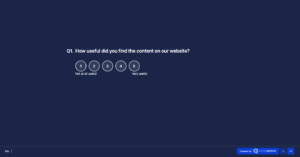
Did you know that nearly 38% of users quickly disengage if they find a website’s content or layout unattractive?
The content of your website decides whether it’s worth spending time on.
The content on a website comprises text, videos, and images, playing a crucial role in its success. Content should interest and inform users while motivating them to take action, like clicking a button and requesting a demo or exploring more pages.
Use these website usability survey questions to gauge the effectiveness, usefulness, relevance, clarity, and conciseness of your website’s content:
- How useful did you find the content on our website?
- Were you able to find the content you were looking for?
- How would you rate content clarity on our website?
- How would you rate the conciseness of the content on our website?
- Do you agree that the content on our website is presented in the right format?
- Could the content have been presented in a better way?
- Were you able to play the video inside the website without any extra controls required?
7. Payment Experience Survey Questions
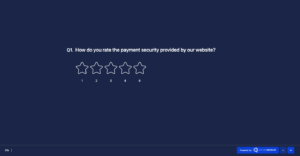
Approximately 21% of online shoppers leave because of lengthy checkout processes. That’s why including questions about payments in a website usability survey is essential, as it aids in pinpointing any issues or areas that need improvement in the payment experience process. Addressing these areas could potentially boost your conversion rate and completion rate.
To tackle these issues proactively and prevent potential customer loss, consider using these payment-related website usability survey questions:
- How do you rate the payment security provided by our website?
- What’s your opinion about the availability of payment methods on our website?
- Did you experience any delays or complications while making a payment?
- Are there any payment methods you expected to find but are missing on our website?
8. Performance Usability Survey Questions
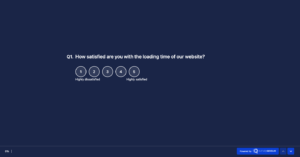
Considering that 40% of users abandon a website if it takes longer than 6 seconds to load, it is very important to keep a check on your website’s performance. That’s where the performance usability survey comes in!
Performance usability survey questions delve into the overall performance of your website. A well-performing website should load swiftly, offer seamless data retrieval and storage, and minimize technical errors or compatibility issues.
Here’s a set of website usability testing survey questions designed to gauge your website’s performance:
- How satisfied are you with the loading time of our website?
- Have you encountered any technical errors or glitches while using our website?
- Did you experience any issues related to browser compatibility?
- How responsive were interactive elements like buttons, forms, and menus?
These survey questions help in boosting efficiency and overall website performance, providing valuable insights to enhance customer experience and satisfaction.
Final Note
Asking the right questions in your website survey is like exploring what your users want. These eight questions help you learn much about how users feel about your website. From the overall experience to details like design and content, these questions give you the keys to discovering what’s working well and what needs fixing.
So, ask these questions, and you’ll uncover the secrets to making your website experience seamless for everyone!
Nonetheless, having a powerful website feedback tool such as SurveySensum simplifies the process. Not only does it facilitate the collection and analysis of user feedback, but its CX consultant assists in translating that feedback into actionable steps for improving user experience.













